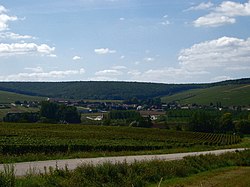Chablis (wine)
| Wine region | |

|
|
| Type | Appellation d'origine contrôlée |
|---|---|
| Year established | 1938 |
| Country | France |
| Part of | Burgundy |
| Total area | 6834 hectares |
| Size of planted vineyards | 4820 hectares |
| Varietals produced | Chardonnay (Beaunois) |
The Chablis (pronounced: [ʃa.bli]) region is the northernmost wine district of the Burgundy region in France. The cool climate of this region produces wines with more acidity and flavors less fruity than Chardonnay wines grown in warmer climates. These wines often have a "flinty" note, sometimes described as "goût de pierre à fusil" ("tasting of gunflint"), and sometimes as "steely". The Chablis Appellation d'origine contrôlée is required to use Chardonnay grapes solely.
The grapevines around the town of Chablis make a dry white wine renowned for the purity of its aroma and taste. In comparison with the white wines from the rest of Burgundy, Chablis wine has typically much less influence of oak. Most basic Chablis is unoaked, and vinified in stainless steel tanks.
The amount of barrel maturation, if any, is a stylistic choice which varies widely among Chablis producers. Many Grand Cru and Premier Cru wines receive some maturation in oak barrels, but typically the time in barrel and the proportion of new barrels is much smaller than for white wines of Côte de Beaune.
Chablis lies about 10 miles (16 km) east of Auxerre in the Yonne department, situated roughly halfway between the Côte d'Or and Paris. Of France's wine-growing areas, only Champagne and Alsace have a more northerly location. Chablis is closer to the southern Aube district of Champagne than the rest of Burgundy.
...
Wikipedia
